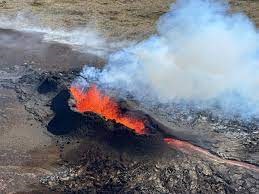Seismic Swarm hit Iceland

Disclaimer: Copyright infringement not intended.
Context
- A seismic swarm has hit the Reykjanes peninsula in southwest Iceland with more than 5,500 small earthquakes in the last three days, raising the prospect of a volcanic eruption.
Details
About Earthquake swarm
- It is a succession of low-intensity earthquakes with no obvious primary shock that can last for weeks in active geothermal locations.
- A succession of earthquakes can occur when seismic energy accumulates inside the Earth and is released in modest amounts from certain spots.
What causes swarm sequences?
Fluid movement:
- This can be fluid discharged from deeper magma or fluid circulating within active geothermal zones (in volcanic locations like the Taup Volcanic Zone).
- Fluid-induced earthquakes occur as faults slip on the fissures and faults through which the water is traveling.
Active volcanism:
- Magma movement can also operate as a 'driving mechanism' for swarms, causing earthquakes as magma-filled cracks push through the Earth's crust.
- In such cases, earthquakes are more likely to occur around the crack tip (the area ahead of the magma where the crack is beginning to open) or to the side of the fissure.
Slow-slip instances:
- Slow-slip events are essentially slow-motion earthquakes that often entail centimeters to tens of centimeters of movement along a fault over weeks to years.
- Slow slip events are prevalent near the Hikurangi subduction zone, with at least one or two occurring per year.
Facts about the Reykjanes peninsula
- It is a peninsula in southwest Iceland with massive lava fields, volcanoes, and increased geothermal activity.
- It follows the Mid-Atlantic Rift, which separates the Eurasian and North American tectonic plates.
|
PRACTICE QUESTION Define what is meant by an 'earthquake swarm' in the context of seismology. Explain the factors that can contribute to the occurrence of earthquake swarms. |





1.png)
